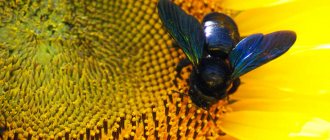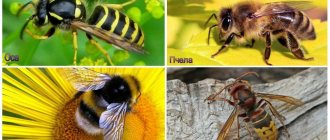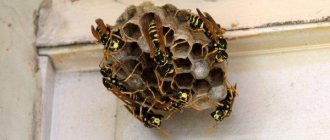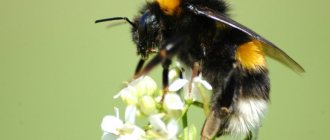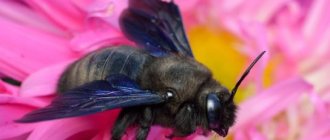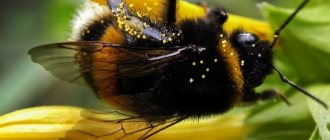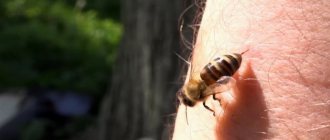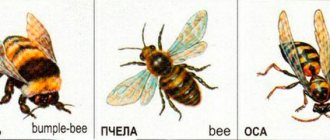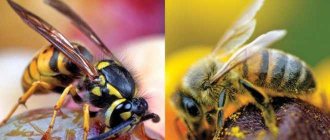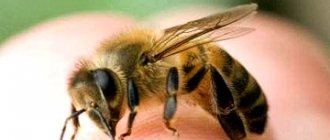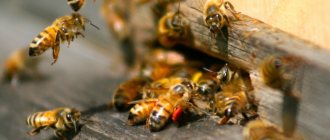The purple carpenter bumblebee, which has a spectacular appearance, belongs to the genus of carpenter bees, that is, insects that build their nests in the remains of tree species. These can be buildings, poles, fences, bamboo. The Latin name for the purple bumblebee is Xylocopa violacea. Refers to relict insects, that is, preserved from prehistoric times. This species has existed since the Paleogene.
Common carpenter bee
The insect belongs to the Apidae family and the species of solitary bees. This particular species has relatively large dimensions - the body length reaches a maximum of 3 cm. In common parlance, a carpenter bee is called a xylocop or a tree nest. In total there are more than 500 species, which unite 30 breeds. Externally, most of them differ only in shades.
Individuals living in Russia are more reminiscent of shaggy flies with a black body and beautiful wings that have a blue-violet or blue sheen.
Description of lifestyle and habitat
The wood bee gets its name from the fact that it makes a honeycomb home in dead wood, cutting multi-level nests with numerous cells, each of which will develop a larva.
During “construction work” it makes sounds as if a modern drill was working. Sounds can be heard within a radius of several meters. The entrance to the monastery is always perfectly round and single, as if it had been drilled with a drill.
Since the nest is created more likely for the future generation, bee children can also use it, but this is not necessary. Typically, only a couple of individuals remain, or even one when the queen dies. To create housing is one of their basic instincts.
There are carpenter bees all over the Earth, but most have settled in the central and western parts of Europe, in the Caucasus. In Russia, solitary insects are found in the Stavropol and Krasnodar territories, the Central Black Earth region, the Volga region and other places where climatic conditions are similar.
Due to the fact that the blue bee's favorite nesting place is dead wood, it is most often found in summer cottages, near parks, forests and groves. Fences, old telegraph poles and other buildings made of this material are ideal shelters for it.
When choosing a location, the location of the food source plays a big role, but carpenter bees can fly many kilometers in search of food.
Lifestyle of bumblebees at the end of summer
At the end of summer, the family matures. Under normal conditions, the queen, having laid 200-400 eggs from which workers emerge, begins to lay eggs from which males and future female founders are born.
Males fly out of the nest when they are 3-5 days old and spend their short life outside it, spending the night on plants. The mating behavior of males of different species is different:
- Males of the subterranean, small rock and other species of bumblebees wait for the female at the entrance to the nest and mate with the emerging female.
- Ground, garden, forest and other bumblebees fly along a certain route and stop at certain points, over which they hang for a long time, fluttering their wings in the air, and also sit down on the ground. At these so-called “buzz points”, male bumblebees leave droplets of secretion secreted from the mandibular glands located at the base of the upper pair of jaws. The smell of this secretion helps them navigate and attracts females. Mating also takes place there.
- Some species of bumblebees choose noticeable landmarks in the area: stones, tree trunks, groups of flowering plants, fly over them and mate with approaching females, who attract males with their appearance and smell.
Soon after mating, the males die, and the fertilized females hide in secluded places for the winter. Bumblebees hibernate in the ground. To do this, they dig holes 5-10 cm deep in dry areas with soft soil. In the spring, they get out of their hiding places and fly in search of a place to build a nest.
Photo credit: Kevin Cole, CC BY 2.0
Do they pose a danger to humans?
The common carpenter bee stings quite painfully, moreover, the toxin that gets into the blood is dangerous. Poison injected into the wound immediately provokes large swelling, which hurts for a long time and severely. The active substance has a depressant effect on the central nervous system and nervous shock often occurs. If it stings the throat, it is fatal.
Bee venom causes severe swelling
When planning to start getting rid of these insects, you should know a few important facts about them:
- The sting is definitely dangerous, but only females sting. Males do not have the necessary organ for this. Representatives of this species mainly hide in the nest and do not come out, so the chance of being stung is minimal. If this happens, you should immediately consult a doctor.
- Wood bees, or carpenter wasps, as many are also called, are very dangerous for wooden buildings, because they violate the integrity of the structure of the massif, gnawing out entire shafts inside. In a few years, a structure with at least two nests can collapse.
- Woodpeckers love to eat them. Therefore, when you see a busy bird, you need to scare it away. The smell of carpenter bee larvae attracts them from several kilometers away. In an attempt to get the delicacy, the birds gouge out even larger holes.
- Blue bees have good reproductive function. One sexually mature female reproduces up to 6 larvae during 1 warm period.
For your information! These insects are listed in the Red Book, therefore it is prohibited to systematically destroy them, but tolerating dangerous neighbors is also not a worthy alternative.
Species of black tree bumblebees
It is easy to confuse different types of tree bees. For example, the common xylocopa will be larger than the purple one. There is also a difference in the color of the wings.
Violacea, Valga, Iris
Blue color is the attribute of the purple carpenter. In total, the genus Xylocopa includes 500 species.
Habitat
All "carpenters" live in dry or rotten wood. Typically, bees choose trees in groves and deciduous forests. Both poles and wooden buildings are used. Habitat of Xylocopa Violacea:
- Countries of Southern Europe, the Caucasus, Turkey, Ukraine, South-West Asia, the Middle East;
- In Russia: the Republic of Crimea, the regions of Voronezh, Belgorod, Kursk and Ryazan, Samara, Penza, also Astrakhan and Vladimir, Krasnodar Territory and Stavropol Territory. The species is distributed in Chechnya, Dagestan, Adygea, Ingushetia and Kabardino-Balkaria; it is found in Tatarstan, Bashkortostan, Mordovia, in the Rostov and Tambov regions.
The bairach forest consists of broad-leaved trees on the slope of a ravine or ravine.
The purple bee, belonging to the genus of carpenters, settles in soft wood, ignoring beech, oak and ash.
Dry wood, Violacea species
Protection measures:
- Use of coniferous wood (not 100% protection);
- Treatment with two layers of varnish: the first layer is used as impregnation, etc. The coloring is not suitable.
An atypical case was observed in Austria in 2004. Bees have gnawed holes in polystyrene slabs.
In any case, the passages turn out to be shallow, especially when it comes to buildings. A rare but possible habitat is the bark layer of a coniferous tree if the bark thickness exceeds 3 cm.
Security
The bee species Xylocopa Violacea was included in the Red Book of the Caucasus regions, as well as the Krasnodar Territory and Stavropol Territory. In Crimea, Volgograd and Samara regions, this species is also protected.
Xylocopa Violacea
Interestingly:
- Xylocopa Valga, that is, “common carpenter” is protected throughout Russia and Ukraine;
- In Belarus, the species Xylocopa Violacea is not protected, but it is found there (Gomel), and this species is included in the Red Book of Ukraine.
The list of protected fauna in each region is supplemented. So the list given here is not complete.
The hornet that resembles tree bees is called Vespa Dybovskii. It was included in the Red Book of the Chita Region. The usual name is the Black Hornet, a pest of all apiaries.
Three types of bumblebees
Well, bumblebees, and not only arboreal ones, do not harm apiary bees. In most regions, the species Bombus Lapidarius, Hypnorum and Terrestris are protected. Translation: stone, hollow, earthen.
How to get rid of wood bees in the wall of a wooden house using a gentle method
Few disinfection services will deal with black bees, as it is illegal. Therefore, the question of how to get rid of tree bees on your own becomes especially relevant. Given the circumstances, the only way to get rid of insects is through sound vibrations.
The woodcutter bee is very sensitive to noise. It is enough to turn on loud music near the proposed housing. Preferably a composition with low frequencies - high-quality bass. Blue bees will leave their wooden home on their own.
Drive away bees with low-frequency music
There is a more aggressive, but effective method.
Remedy for blue bees
How to deal with tree bees if noise does not help?
The easiest way to protect your home from these insects is with sticky traps for flying insects. But it is effective for single catching.
In addition to this, there are other means:
- If the pests are very annoying and pose a real danger to the health of the household, you can sacrifice one generation of them to ensure that they are not in the old holes forever. To do this, you need to fill the entire socket through the main passage with an aerosol carburetor cleaner or ordinary gasoline. At the same time, it is worth remembering safety measures with such toxic substances, especially when it comes to working with wood.
- Special pesticides, especially powder ones, are quite effective in destroying homes. The most commonly used are boric acid or carbaryl.
Important! The individuals themselves are not aggressive. If the carpenter wasp does not feel a threat to its life and the integrity of the “house”, it will not attack.
Complications and prognosis after a bite
The most common consequence of an insect or animal attack is swelling of the respiratory system. It appears in 2-5% of victims. Edema is controlled by intramuscular injection of glucocorticosteroids. In the absence of timely assistance, pulmonary edema leads to death.
In 0.5% of cases, after a bite, anaphylactic shock is observed - a severe allergic reaction of the body to toxins and poisons. Mortality from anaphylactic shock is high - 25% with timely assistance and 50% without treatment.
Severe consequences occur in patients after multiple bites, for example, multiple organ failure. The disease provokes accelerated death of red blood cells. Remains of cells settle in the kidney and liver tubules, complicating the functioning of internal organs. If one organ is affected, mortality occurs in 20% of cases, two or more - in 60% of cases.
Preventive measures
Having gotten rid of carpenter wasps once, no one can guarantee that they will no longer appear in the house or building where they lived before.
To do this you need to perform certain manipulations:
- After the nest is destroyed, you need to stuff everything with mineral wool, steel wool or polyurethane foam. All these materials are classified as sealing materials, and the insects will not be able to return to the monastery, and the remaining ones will definitely die.
- Experienced gardeners claim that wood wasps do not settle on buildings treated with paints and varnishes. Therefore, this is the most reliable way to prevent the formation of nests, and therefore the accumulation of bees.
- You can also use citrus spray on wooden buildings to prevent pests from returning. The product can be purchased at a special store or made with your own hands. Most bees die from it, and the survivors leave danger in the territory in the genetic code, and their descendants will not settle in the same place.
Methods for getting rid of insects
If colonies of carpenter bumblebees are found in the wood on your property or local area, it is recommended to get rid of the insects. This is achieved in different ways.
Measures to exterminate bumblebees:
- traps made of boards with a bottle filled with water inside;
- traps with ultraviolet lamps;
- eliminating nests with diesel fuel, gasoline or soap solution;
- location on the site of a device that produces loud sounds - you can turn on music regularly (this will help the bumblebees leave the site faster);
- treating areas of accumulation with scented sprays or herbal decoctions with mint, lavender, thyme or onion;
- destruction of bumblebee larvae - pouring machine oil into the nests.
The black bumblebee looks like a large bee with a smooth body and blue wings. However, insects differ in behavior. Carpenter bumblebees do not live in a strict class division of the family, but prefer to build nests on their own, sometimes forming small colonies of females. At the end of the body, females have a sting, unlike males. Therefore, bumblebees are dangerous to humans, although they rarely bite, since they are often non-aggressive.
24.08.2020
The purple carpenter bumblebee (lat. Xylocopa violacea) belongs to the subfamily Carpenter bees (Xylocopinae) from the family Apidae. This large, hairy bee with blue or purple wings with a wingspan of up to 5 cm reaches a length of 3 cm. It is a pollinator of 17 species of flowering plants.
A distinctive feature of the insect is the ability to gnaw complex passages in wood, which can safely be called a masterpiece of carpentry. For this skill it got its name. It is also called the tree bumblebee, woodcutter or xylope.
In China, tinctures with it are used in folk medicine to strengthen the immune system and treat many diseases. They are supplied to Japan, where they are traditionally very popular among fans of natural healing potions.
Features and habitat of the carpenter bee
Carpenter bees prefer to settle in places with a warm climate that are not subject to sudden temperature changes. They build their houses mainly in steppes and forest-steppes, on the edges of deciduous forests or in foothill areas.
Carpenter bee collecting nectar
Geographically, this species of bees settled in Central and Western Europe and the Caucasus. In Russia, they are found in the Krasnodar and Stavropol territories, the Volga region, the Central Chernozem region and other places with similar climatic conditions.
Character and lifestyle of the carpenter bee
Carpenter bees do not gather in swarms or small families, preferring to live separately from other members of their own species. Due to the fact that the favorite places for building nests of these insects is dead wood, they can often be found in summer cottages in wooden houses, fences, telegraph poles and other buildings.
When choosing a place to live, proximity and ease of finding food do not play a big role, because carpenter bees are able to fly gigantic distances in search of nectar.
The adult years, and, accordingly, the greatest activity of carpenter bees occurs from May to September, sometimes to October, under favorable weather conditions.
Behavior
The purple bee begins to fly from mid-April. The flight ends around the end of September. As a habitat and for breeding offspring, the purple bumblebee chooses typical carpenter's places: fence posts, utility poles, dry tree trunks, rocks, abandoned rodent holes. Prefers open places: near populated areas, on the edge of the forest.
In any habitat, choose the sunny side, not the shade. The purple bee chooses a location next to a person not because of its proximity (it prefers privacy), but because of the abundance of suitable materials for building nests.
Over thousands of years of coexistence with humans, purple carpenter bees have developed certain habits. Sometimes you can see them inspecting panel or concrete houses. They are looking for a suitable rotted beam or ceiling. Human activity forces them to such searches. Forestry departments clear forests of dead wood, sanitary felling deprives carpenter bees of the opportunity to quickly find suitable housing.
New generations of bumblebees are in no hurry to leave their father’s house for good: up to 10 generations can live in one nest or until the wood deteriorates. The food of adult purple bees is nectar and plant pollen.
Carpenter bee feeding
The diet of carpenter bees is completely different from the diet of ordinary bees. The main source of food for them is plant pollen. Sources of strength, energy and carbohydrates for adult bees are honey or nectar.
When collecting pollen, bees soak it with their own saliva and dilute it with nectar, which is stored in their honey crops so that the pollen does not scatter during long flights.
The microbes contained in the saliva of bees immediately start the fermentation process, which turns the pollen into bee bread (or bee bread), which is eaten by both adults and newly born bees. Special glands of young bees transform bee bread into protein-rich royal jelly, which is fed to the larvae.
Reproduction and lifespan of a carpenter bee
The peculiarity of the reproduction of carpenter bees is that each female creates her own home and her own offspring. Breaking through a tunnel, the female brings pollen mixed with nectar to the bottom of the branch and lays an egg in this nutritious mass.
It is these reserves that the larva will feed on all the time until it reaches the stage of an adult bee. The mother bee then creates a barrier over the egg made of sawdust and other small particles, glued together with the bee's saliva.
After this, the cell is sealed, and the mother never looks inside it again. On top of the partition, the female again brings and stores food and lays an egg. So, cell by cell, it turns out to be something similar to a multi-story house for future bees. Until mid-autumn, the bee continues to live and protect its own nesting site, but by winter it dies.
The larvae enter the pupal stage by the end of summer, and then young bees emerge from the pupae. All winter they remain locked, each in their own cell, but by the beginning of May, stronger and ready to create their own nests, they gnaw their way into freedom and fly away in search of blooming flowers.
Due to the fact that carpenter bees often choose human buildings as their home, sooner or later in such a neighborhood the question arises about the danger that this insect can carry within itself.
The sting of a carpenter bee is not just unpleasant, it carries a real danger and threat to human health and life. By biting, the carpenter bee injects poison into the wound, which immediately causes very large and painful swelling.
In addition, this poison has a depressant effect on the nervous system, which is why nervous shock is a common side effect. A bite to the throat is fatal.
You cannot simply destroy potentially dangerous neighbors from year to year - carpenter bees are listed in the Red Book, and their population is protected. However, enduring them on your site, simply hoping that everything will work out, is not the best way out of the situation. So how can you get rid of carpenter bees in your own home?
The best way out of the situation may be to expel them from the area using loud noise. Bees are very sensitive to vibrations of various kinds. Therefore, if you play loud music with high-quality bass near their intended home, the bees will leave their home themselves. The disadvantage of this method may be neighbors complaining about noise.
Sometimes one generation of bees can be sacrificed to ensure that they do not return to their old burrows. To do this, just fill their passages with an aerosol carburetor cleaner or gasoline. Remember to take precautions when working with these liquids - take care of your own safety.
What behavior does the black bumblebee have and how does it reproduce?
The black bumblebee differs from other members of the family in its large body size (27 mm). All individuals are assigned to the genus Xylocopa. The insect has a completely black color with the effect of purple reflections. At first glance, it may seem to ordinary people that there is a fly in front of them. Blue bumblebees live solitary lives, never creating large working families under the leadership of an authoritative queen.
- The bee has a fairly calm disposition and will not attack a person passing by. However, the bite force of the black (blue) bumblebee is several times higher than that of an ordinary honey insect.
- The large head with a purple tint is striking in its size, and the blue bumblebee has very powerful jaws. Due to the unique sticky cover of their legs, these creatures collect large amounts of pollen from plants, trees and flowers.
- They were nicknamed carpenters because they prefer to make their homes in the trunks and attics of people’s homes. Capable of chewing long tunnels on the roofs of houses.
- In their nests, insects build special partitions, where, having collected a sufficient amount of pollen, they lay eggs and seal the passages in their homes.
- The larvae of the black (blue) bumblebee mature on their own and, upon hatching, begin to gnaw their way to freedom.
- When this active insect is busy with its activities, a person calmly resting hears a rather loud sound.
We suggest you read: Why is the bumblebee striped for children?
On a note!
The black bumblebee is very rarely found in nature and is listed in the Red Book. The present species inhabits the central and western territories of the Old World.
From May to June, hardworking bees diligently collect nectar from a variety of plants and flowers (white acacia, willow, red clover).
Scientists compare the behavior of a loving pair of bees with the mating behavior of some species of birds. The male individual bravely rises to the surface of an elevated place and for a long time with great courage guards the territory from the encroachments of other males. Future mothers of cubs also try to occupy heights where they will meet a potential partner.
It turns out that in each separate section an embryo develops, and nectar is lovingly and abundantly left around, which will serve as food for the newborn individual. The fathers and mothers of the family, having closed the entrance to the nest, leave it forever.
Varieties of bees
- The common bumblebee is sometimes confused with a wasp, which also has yellow stripes on its body. Bees have a calm disposition and rarely sting humans.
- Honey-bearing specimens are more hardworking, therefore they are in great demand among beekeepers. Brown and golden stripes are visible on their abdomen. Honey bees differ in the specifics of their nutrition and life activity.
- The black bumblebee from the American continent is a productive nectar collector. This specimen is endowed with an active and nervous character, and begins to rush about passionately when the beekeeper opens the hive.
- The German bee has a strong immune system and a calmer disposition. There is a great stratification in the family: some create huge families, others remain hermits.
- An insect from the northern regions of Africa behaves most aggressively in the apiary. The species is famous for its fertility. When keeping insects, beekeepers use personal protective equipment, since the bite of the black bumblebee is quite sensitive.
- Specimens from central Europe are actively engaged in reproduction in autumn and spring. Endowed with strong immunity against popular diseases of the species. If you disturb them, they begin to behave irritably and sternly.
- The black Sicilian bumblebee has a long proboscis and a peaceful nature. They never allow themselves to steal other people's supplies.
On a note!
Science knows a wide variety of black bumblebees. Each species has a unique behavior, coloring and body structure. Beekeepers value those individuals that hardworkingly collect nectar and take it to the apiary, where healing honey is obtained.
Black bee
Most people think of bees as yellow insects with black stripes. But there are other varieties: black individuals. Carpenter bees are found in the wild; domestication is not yet possible. In total, there are more than 700 varieties of carpenter bees, depending on their distribution area: American, German, African, Sicilian, European, Central Russian.
Carpenter bee: description with photo
The common carpenter bee has a black body and purple wings. It got its unusual name because of its love of living in attics, trees, and wooden posts. Insects do not form large families and are not distinguished by aggressive behavior towards humans. Large hairy legs allow the insect to bring large amounts of pollen.
What does a carpenter bee look like?
The appearance allows one to often confuse the bee species with a fly or bumblebee. This is a large black bee with a dense, round body. Females are larger than males, body size 2-3 cm. In the head area, the color has a bluish or purple tint. The carpenter has purple wings with blue streaks. The body and legs of the insect are covered with a large number of hairs. By pre-wetting them, the carpenter bee is able to collect a large amount of pollen and process it into nectar. The offspring of the carpenter moth feed on nectar.
Only female carpenter bees have a sting. Tree drones cannot sting. After being bitten, the woodworm loses its sting and dies.
Distribution area
The distribution range of carpenter bees is quite wide. The black bee, as in the photo, can be found in Central and Western Europe, Transcaucasia, Central Asia, the Middle East, and Mongolia.
On the territory of Ukraine, the carpenter bee is listed in the Red Book. In Russia, carpenter bees are found in the Urals, the North Caucasus, Stavropol, Krasnodar, and Moscow region.
What do tree bees eat?
The tree bee feeds on the nectar of more than 60 flowering plants. These are not only herbaceous plants, red clover, but also trees and shrubs. Carpenter bees especially love white and yellow acacia.
Carpenter bees soak pollen with saliva and nectar. Microbes in saliva activate the fermentation process. The result is bee bread or bee bread.
Life cycles and reproductive features of the carpenter bee
The black wood carpenter bee is a solitary bee and does not live in a family. The female creates a separate home, separate offspring. To nest, the bee digs a tunnel through dead wood. To do this, the carpenter bee uses powerful chewing jaws.
During the breeding season, drones fly around their area, trying to drive away possible rivals. To protect the area, males choose high places to make it more convenient to patrol the territory. During this period, females begin to fly higher in order to quickly meet the long-awaited gentleman.
A nutrient mass of nectar and pollen is placed at the bottom of a tunnel dug in the wood. Eggs are laid in it. The larva emerging from the egg will feed on these supplies until the adult carpenter bee stage. Directly above the egg, the female black tree bee constructs a barrier of small particles and sawdust glued together with saliva.
Each cell serves for its own egg, a new cell is created on top, and an entire multi-story structure is built.
The carpenter bee keeps the nest until mid-autumn, and all this time she guards it. The carpenter bee then dies.
The larva turns into a pupa at the end of summer. Young black carpenter bees remain in their burrow throughout the winter and only emerge in the spring. It is then that you can see young black bees with blue wings. Black carpenter bees begin to create their own nests at the end of May.
Description, appearance and characteristic features
The black carpenter bumblebee is a solitary insect from the genus of carpenter bees. This is a relict insect that existed on Earth in prehistoric times. Its appearance differs from the usual bee appearance. The carpenter bumblebee is a black insect with a blue tint on the abdomen and head and blue-violet wings. Due to the active work of its wings, when a bumblebee flies, it seems that it is purple. The head is massive with a powerful jaw, large eyes, long black antennae with red spots at the ends.
Representatives of this species are among the largest among the entire family. The body size of an adult reaches 3 cm. The insect has heavily pubescent legs, but the hairs on the body are sparse. Due to this, the body looks smooth and glossy.
Appearance
Does a carpenter bee bite or not?
Carpenter bees rarely show aggression towards humans. If you do not try to destroy or interfere with it, then it is peaceful. When meeting a person in the absence of danger, he calmly continues on his way. If you tease and try to grab these insects, you can get a bite, which is quite painful. The sting remains in the human body, as with the sting of an ordinary bee.
How dangerous is a carpenter bee sting?
It is important to understand that a tree bee sting is not just painful, but quite poisonous. If a person is healthy and does not suffer from hypersensitivity, then a tumor will form at the site of the bite.
Carpenter bee venom has a depressant effect on the human nervous system. Therefore, nervous shock is often a side effect of such an insect bite.
In order to avoid unpleasant consequences, it is recommended to immediately remove the sting. Then the algorithm of actions is as follows:
- Pull out the sting, being careful not to crush it.
- Squeeze the poison out of the wound.
- Apply gauze to the wound made from an aqueous solution of ammonia in a ratio of 1:5.
- Bandage the wound.
In the absence of ammonia, many experts advise applying salt to the wound. It needs to be mixed with water to the consistency of a thick paste. It will be possible to reduce pain, relieve painful swelling, and reduce an allergic reaction.
Another traditional medicine that helps with a tree bee sting is the milky juice of dandelion. The sting should be removed and the wound thoroughly moistened with juice.
Rules for dealing with a carpenter bumblebee bite
If a large carpenter bumblebee does attack, then you will need to provide proper assistance. The bite site turns red, swells, and hurts. Allergies to proteins and other substances from the venom can cause serious side effects, especially from a bumblebee bite to the neck or head. Therefore, it is important to know about the symptoms and actions that can prevent serious consequences from an insect attack.
Bumblebee bite: do bumblebees sting people and what to do if bitten at home, read more in this article.
Symptoms and consequences of bumblebee bites
After a bumblebee bite, the smooth sting either remains under the skin or not. However, this does not change the symptoms. Everything gets worse if a person has an allergic reaction to the components of the injected poison.
Characteristic signs of a bumblebee bite:
- soreness;
- local increase in temperature;
- itching, burning, redness;
- swelling, swelling;
- compaction of the affected area.
The appearance of symptoms occurs in the first minutes after the sting digs under the skin. A peculiar reaction usually lasts several days, depending on the characteristics of the body. If you scratch the bite site, the problem will only worsen and drag on for a long time.
Negative consequences are associated with allergies. Examples:
- widespread redness and swelling extending beyond the bite site;
- the appearance of a rash, large blisters on the body;
- gastrointestinal reaction - nausea, vomiting, diarrhea;
- difficulty breathing, suffocation;
- chills, general increase in temperature, fever;
- interruptions in the functioning of the heart or blood vessels.
With a sharp and powerful allergic response, there is a possibility that anaphylactic shock will occur. There is a lack of air, convulsions, dizziness, and loss of consciousness. No less dangerous are multiple bites, which are characterized by general weakness, nausea, and changes in heart rhythm.
First aid for a black and blue bumblebee attack
After a bumblebee stings, you need to take a number of actions to reduce the symptoms and prevent serious consequences. These are usually fairly standard procedures for dealing with an insect bite. Instructions:
- Pull out the sting if it remains in the skin so that high intoxication does not develop.
- Treat the affected area with an antiseptic solution (potassium permanganate, hydrogen peroxide, alcohol) - reducing the risk of secondary infection.
- Apply a cold compress to reduce pain and swelling.
- Take an antihistamine to relieve or prevent allergy symptoms.
- Drink plenty of liquid to remove toxic substances from the body.
- Call an ambulance immediately if your condition quickly deteriorates.
At the same time, it is forbidden to kill the insect, as other members of the family may flock together. It is also recommended to refrain from scratching, as this spreads the infection. The use of sleeping pills or alcoholic beverages is prohibited.
Allergic reaction to bumblebee venom
After a bite, venom and insect saliva are injected into the bloodstream. Some people develop an allergic response to the toxin or proteins. Such a reaction does not occur immediately. Upon first contact with a bumblebee, antibodies are produced. When the antigen (allergen) is repeatedly exposed, the characteristic symptoms of an allergic response already appear.
Antihistamines for bumblebee bites: Psilo-balm, Fenistil-gel, Claritin and Suprastin.
Preventing an attack
It is recommended to avoid attacks by carpenter bumblebees according to the following rules: do not make sudden swinging movements; do not walk barefoot on the grass. In addition, in nature it is better not to wear bright clothes or use perfume with a strong aroma, and to minimize the area of open areas of the body. Nets on windows help keep flying insects away. If there is sweet food or fruit nearby, you need to make sure that bumblebees do not land.
How to deal with tree bees
Tree bees can be controlled by several available means. It is important not to destroy bees in large numbers, since tree insects are rare and are listed in the Red Book. But it is not recommended to leave them on the site from year to year, since insects are dangerous in large numbers to humans. Children are most often affected; insects pose the greatest danger to allergy sufferers.
The blue carpenter bee can be a real disaster if it takes up residence in the logs of a house or barn. The most popular and easiest way is loud music. It will help if wood insects appear in the garden or area. It is enough to take an audio system with loud bass outside, and after a while you can detect a positive result. The main thing is that the neighbors don't mind.
How to get rid of carpenter bees in your home
You won’t be able to get rid of a carpenter bee in your house using loud music - it’s too much inconvenience for the residents themselves. Therefore, other methods are used:
- boric acid or carbaryl - used to destroy active wasp nests;
- specialized powdered pesticides;
- tree bee trap.
The trap is used not only in the house, but also on the site. Easy to make with your own hands.
How to Kill a Carpenter's Bee in a Barn
In non-residential premises and on the site, the carpenter bee can be easily removed with special pesticides that eliminate active nests. If such means are not at hand, there are more accessible substances:
- carburetor cleaner - any motorist can find it in his garage, and spraying this substance will not kill the bees, but will quickly leave their habitat;
- gasoline, diesel fuel - poured directly into the nests, and the effect occurs almost immediately after the liquids enter the nests of the arboreal bee;
- mechanical impact helps if there are few bees in the area, in which case they can be knocked down with a racket or net, and then crushed.
When using the mechanical method of destruction, it is important to be careful so that the insect does not bite. There may be complications, especially if there is an allergic reaction. It is necessary to knock down the suspended insect with one blow, then immediately crush it.
Natural enemies of carpenter bees
Photo: Common carpenter bee
Thanks to their impressive size and durable wooden homes, carpenter bees have far fewer enemies in the wild than regular honey bees. First of all, these are, of course, insectivorous birds - bee-eater, shrike, golden bee-eater and many others.
Danger awaits carpenter bees in the habitats of frogs. They feed on different types of insects, but do not mind eating a bee, grabbing it in flight with their long sticky tongue. Another predatory representative of lovers of these insects is the spider. It weaves its web in the immediate vicinity of bee nests and catches unwary bees with it.
No less dangerous for carpenter bees are their distant relatives such as hornets. They are twice as large, very voracious and can destroy bees in large numbers for their own food.
Another natural, although not the most dangerous, enemy of the carpenter bee is dragonflies. They do not always attack, especially against such large representatives of bees. They prefer easier prey. However, in those years when dragonflies breed too actively, there is not enough food, and carpenter bees end up in their diet along with other insects.
And in the immediate vicinity of the surface of the earth, carpenter bees lie in wait for mice and other insectivorous rodents. Most of them are not able to reach the nests of carpenter bees and destroy them, as they do with the hives of ordinary honey bees, but adults quite often end up with these small predators for lunch. Since carpenter bees are not tamed or domesticated by humans, they do not have to wait for help in the fight against natural enemies.
Carpenter bee: description
An interesting insect is the common carpenter bee. Absolutely different from her brothers. Leads a solitary lifestyle, does not accumulate honey reserves, does not have a large brood and is rarely used by humans to achieve their goals.
External characteristics
It's quite easy to recognize. These carpenter bees are large in size, more reminiscent of a bumblebee. But what distinguishes the carpenter from him is his dark purple color with a lot of fluff. The yellow stripes familiar to bees are absent. Dark, but slightly lighter than the abdomen, wings with an abundance of membranes. The female is much larger than the male, but there are a number of characteristic differences:
- there is no proboscis for collecting nectar;
- the antennae on the head are black with yellowish tints on the lower part;
- the hind limbs of the female have several teeth and a peculiar platform;
- Only females have a sting; drones do not pose a danger to humans.
The carpenter bee has a short life cycle, about six months. During this time, the insect produces only one small brood and usually dies in the spring. They rarely enter winter quarters.
Distribution area
This is a rather rare species that was listed in the Red Book as endangered. More common in warm regions:
- Europe;
- Transcaucasia;
- Middle East;
- Central Asia;
- Mongolia.
Rarely found in Russia. Its presence was detected in the Rostov, Tula, Moscow regions, in the Stavropol and Krasnodar territories. This type of bee xylocopa is also rare in the Urals and Volga region.
What do tree bees eat?
Despite the fact that it is not a honey plant, it makes food reserves from nectar and pollen. Preference is given to the following honey plants:
- clover;
- spring color of fruit trees;
- acacia;
- willow color;
- Linden.
In summer, it can be found in fields with sunflowers, lupines, decorative and other flowers. Nectar is collected in the early morning and evening at dusk. Xylocopa or carpenter is an exceptional pollinator and is therefore of interest to humans.
Life cycle of a carpenter bee
This insect leads a solitary lifestyle. They can rarely gather in small families. There is no swarming feature. To build a nest, it selects the trunks of dead trees, country wooden fences, stumps, telephone poles, and wooden parts of the roof in suburban areas. To create a nest, they gnaw out cavities in the tree, the entrance to which looks like a perfectly even hole. During this work, it creates a characteristic sound that is similar to the buzzing of a drill.
The nesting site is not tied to the proximity of honey plants. An active insect can fly tens of kilometers in search of food. No matter where the carpenter bee's nest is located. These insects are most active in the summer. If the autumn is warm, they can remain active during this period of the year. They rarely overwinter, usually dying with the onset of cold weather, having previously laid a small part of the eggs.
Reproduction
Purple carpenter bumblebees look for a mating partner mainly in the spring. Males are highly competitive and polygamous, leading an extremely active lifestyle, expelling competitors from their territory. Each male fertilizes 3-5 female bees. New “wives” are lured by a loud buzzing sound while sitting on a branch or bush. When they say that this is a solitary insect, they mean males. Female bees can live in small colonies, including their sisters or daughters.
The female, instead of protecting the territory, is engaged in building a nest. Thanks to the structure of the oral apparatus, it is not only capable of grinding wood into dust, but also gnawing out fairly large whole pieces. The work is accompanied by a characteristic sound that a person can hear 10-20 meters away. The sound is described as "inducing primal horror." The canal that the bee gnaws out turns out to be quite large, about the diameter of an adult’s finger. Having gone to a depth of 8-10 cm, the female insect turns down and makes cells.
One egg is placed in each cell. One female creates one nest per year. The masonry consists of 10-12 adjacent cells gnawed into the wood, filled with pollen. The female diligently collects pollen, delivering it to the “house” on the hairs of her legs. The last cell is gradually filled with supplies. When there are enough of them, the female lays an egg and seals this cell with a dense membrane of “lumber” (wood sawdust held together with her own sticky saliva). The process is repeated for the next cell. When all the eggs have been laid, the entrance is also sealed and the female flies away.
In such a home, future bees develop without external help, using the food left for them. Young insects (imago) overwinter where they hatched - in wood. In spring, young bumblebees come out. Everyone eats their own way out.
